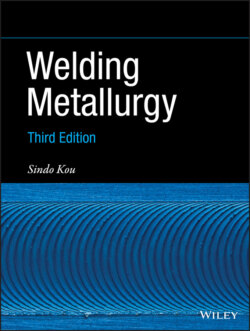Читать книгу Welding Metallurgy - Sindo Kou - Страница 55
1.6.4 Diffusion Welding
ОглавлениеDiffusion welding is a joining process in which the main mechanism for joint formation is solid‐state diffusion. It is often called diffusion bonding. Coalescence of the faying surfaces is accomplished by applying pressure at elevated temperature as illustrated in Figure 1.41 [1]. The faying surfaces need to be machined very smooth and clean. However, microscopically the faying surfaces are still rough and need to be brought into close contact under pressure at elevated temperature. The elevated temperature softens the materials, allowing close contact under pressure and increasing the diffusion coefficient.
Figure 1.41 Diffusion welding between an upper piece and a lower piece showing the microstructure in the vertical cross‐section near the faying surfaces [1].
Source: Welding Handbook, Volume 3, 1980, © American Welding Society.
There are two main advantages of diffusion welding:
1 High‐quality joints can be produced with microstructure and properties close to those of the base metal.
2 Dissimilar metals that are not weldable by fusion welding can be joined.
Disadvantages include the following:
1 High equipment cost and long joining time are often required.
2 Great care is required in preparing the faying surfaces, and the fit‐up of mating parts often need extra care.
